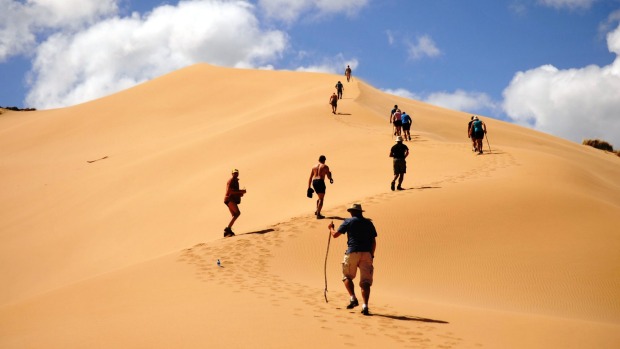
As the sun sets on crimson cliffs and the waves roar in off the Agulhas Bank, it is spine-tingling to know we stand on the exact spot archaeologists believe modern human behaviour began. Not in Eurasia about 50,000 years ago as thought until recently, but here at the southern tip of Africa, about 180,000 years ago.
The Point of Human Origin caves at Pinnacle Point near Mossel Bay at the beginning of South Africa's Garden Route are an "Oh my God" moment for world archaeology.
Only relatively few people so far have visited these archaeological wormholes into the Middle Stone Age and we are fortunate not only to experience these breathtaking caves but also to be guided by South African archaeologist Dr Peter Nilssen, who discovered the caves with colleague Dr Jonathan Kaplan.
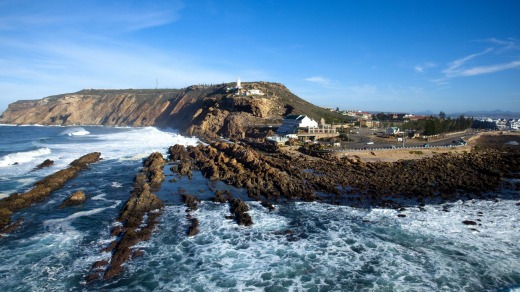
A passionate man, Peter argues that our technologically advanced but ethically challenged world has much to learn from the sophisticated belief systems of these earliest modern humans. These were not your average Neanderthal given to breaking rocks over adversaries heads, but people whose superior cognitive abilities and spirituality are evidence of their modernity.
The Point of Human Origins experience is part of the Oystercatcher Trail, a four night, three-day 55-kilometre Garden Route guided-slackpacking hike that follows the coast from Mossel Bay to the Gouritz River mouth along a track marked at regular intervals with a stencil of the endangered African Black Oystercatcher.
Today's much-travelled hikers want wonderful terrain and geological, botanical, culinary and historical marvels. And, if possible, a deep bath, a glass of wine, good food and a soft bed for weary bones. The Oystercatcher Trail offers this but it also has the unforgettable caves' experience.
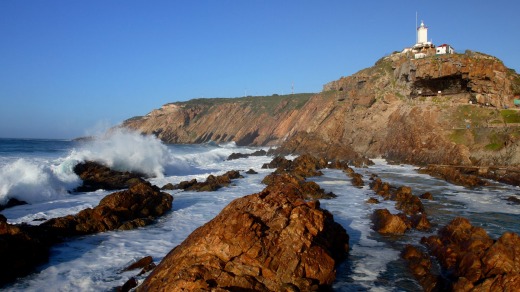
However it is not a one-issue hike. This is a unique coastline lined by Cape Fold sandstone cliffs, decorated with Garden Route fynbos and fringed by an ocean which, fed by the nutrient and mineral-rich Agulhas and Benguela currents, is an aquatic haven.
Chief guide Willie Komani, a local Xhosa man with a deep understanding of the trail's micro-ecosystems, and guide Lisa-Marie, who has a strong affinity with the ocean and with rather more confronting creatures like snakes, accompany us.
There are 11 hikers - Australians and South Africans ranging from our 30s to 70s. The hike can be physically demanding - two people will pull out of certain sections - but the oldest participant has been 83 and the youngest six.
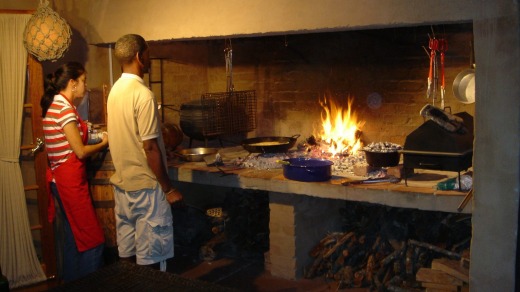
We gather at the luxurious Ana's Place which perches in its eyrie above Mossel Bay at the start of the Garden Route. Below us is the sandstone heart of the town, then the sparkling Indian Ocean with the Outeniqua Mountains silhouetted in blue.
Nature conservationist and trail operator Fred Orban joins us over some rather fine local Jakkalsvlei wines. His affable nature combines with his love of the country and while he no longer hikes, he always dines with us.
Some of the group sport new hiking boots and Fred offers a novel blister-proofing suggestion - Vaseline or Vicks. He warns us about hats and sun cream, for the walk is relatively unshaded, and two Canadian hikers have recently suffered serious burns. Some are concerned about the daily distances - up to 21 kilometres. And rock hopping: that natty hiking gear may well conceal the odd knee and hip replacement.
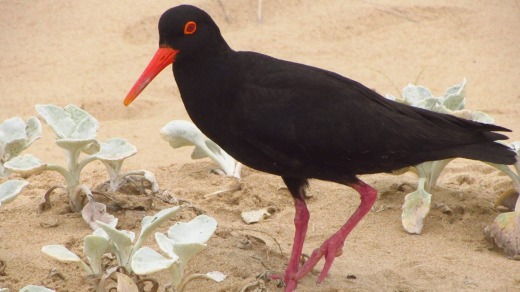
If fact, if you were the worrying type, you might not have slept that night, despite the luxuriously coiffed beds. There's talk of snakes - the aggressive Cape Cobra and puff adders, particularly, whose neurotoxic venom can be lethal.
But those concerns fade once we have strolled to dinner at Route 57 Restaurant for a fine meal of Franschhoek salmon, pepper-crusted fillet, grilled line fish, springbok carpaccio, ostrich and kudu medallions.
The sun rises hot on our first day. We'll hike about 15 kilometres from Mossel Bay to Pinnacle Point for those choosing the cave experience or Dana Bay for those walking on.
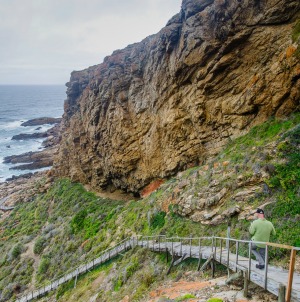
We collect lunch packs and hike to breakfast at St Blaize Cave. This is the biggest of 15 caves in the Cape St Blaize area and our first significant archaeological site for its early Khoisan middens.
With the eastern sun to our backs and a cooling breeze off the sea, a steep climb delivers us to the meandering coastal contour path and here we go with the snakes again: "I don't want to scare you," begins Willie, "but beware of puff adders. Last week one chased me. I heard a 'shh' in the bushes. Lucky I had a stick." Thanks, Willie.
"Don't forget spotted harlequins, skaapstekers and rinkhals," adds Lisa-Marie, the snake lover.
Fortunately last night was a "blood moon" - a good omen, Lisa-Marie says. It also explains the calmness of the normally tumultuous sea. Hundreds of dolphins and squalls of gannets and gulls accompany us, feeding on the pilchard shoals. The whales are due between July and October.
The coastal fynbos is a botanist's delight - around each corner, scarlet and green bells, miniature cream puffs, tiny stars and mauve explosions reveal themselves with a waft of spice that identifies Cape Floral Kingdom fynbos. Don't expect ostentation - his is delicate heath, one of nature's miniatures.
The 15 caves of Pinnacle Point herald the beginning of our four-hour Point of Human Origin experience which includes Peter's presentation, then a tour down about 200 steps to the caves.
Genetic research has shown that all humans alive today stem from a core population of some 600 individuals who lived about 165,000 years ago. The Pinnacle Point caves discovery indicates they lived here, in the Mossel Bay area.
There is no public access unless you undertake this scientific expedition. Excavations continue under the direction of Professor Curtis Marean, director of the Institute of Human Origins at Arizona State University, who initiated the research into the origin of modern humans.
It's fascinating stuff. Peter covers the Stone Age, sea levels, cave formation and archaeological deposits, excavations, the archaeology of modern humans, when and where modern human behaviour emerged and, most interesting of all, where to now as a species.
It's almost dark when we arrive at Fred's Sandpiper Guest Cottages in Boggomsbaai, a tiny coastal village of about 120 houses and our base for the next three nights. A major plus of this trail is that while we walk point-to-point, we are ferried back to our spacious thatched Cape cottages with their indoor "kaggels" or fireplaces, Oregon and yellowwood beams and in Seaview, our cottage, an enormous bath! Bliss for tired bones. There's a welcoming platter of fruits and nuts, a precursor to the trail's generous country meals.
After breakfast on day two we are taken back to Dana Bay for today's 13-kilometre beach hike. Today is oystercatcher day - in fact, oystercatchers eat mussels, not oysters. Willie tells us they live for 40 years, "are loyal and only marry once" and breed between September and March.
The female lays in the sand and sits on the eggs for 31 days. This cools the eggs, which can otherwise cook. If people approach, the birds leave the eggs to draw the danger away. Predators include snakes, mongooses , gulls and people.
There are 18 pairs along this stretch, relaxed now their chicks have flown but two pairs are still distressed at our (distant) presence, indicating late hatchings. At 12, oystercatchers from Durban to Cape Town fly off on a giant gap year to Namibia for "their initiation ceremony", only returning to their birthplace three to six years later.
This is a day of giant sand dunes, middens, inlet rivers, pristine swathes of beach, bluebottles and the ubiquitous carnivorous plough snails. Shoes are cast aside (particularly new shoes) and there's some cavorting in the waves, though not too deep as surfer Lisa-Marie says hammerheads and great whites lurk just beyond the breakers.
A mad dash ensues when the little white cottages of Boggomsbaai become visible, for massages have been booked - neck and back and, oh ecstasy, feet. I'm so relaxed not even Seaview cottage's visitors book has the capacity to alarm: "Gorgeous place - watch for the scorpion" reads one entry. And "The puff adders in the nearby bush added excitement".
Day three is our 21-kilometre day along beaches and rock ledges to Gourits River mouth. Willie tells us not to panic but instead to "get up and clap and dance and put one foot ahead of the other." He shares his vast knowledge about local remedies – wild dagga (a type of cannabis) for snakebite, rhus for coughs, wild rosemary for headaches and so on. We're rejuvenated by a beach lunch of pasta bake, salad and koeksisters (fried sweet treats) and at last we are at the river, where icy beer awaits.
Back at Sandpiper Cottages, our farewell dinner starts with champagne and huge local oysters, Willie sings us the Click Song in Xhosa and the blood moon reminds us of our good fortune - we've survived the hike, avoided the snakes and learned a thing or two. What more could you ask.
The writer was a guest of the Oystercatcher Trail
humanorigin.co.za
South African Airways has a fare to Johannesburg for $1858 return from Sydney and Melbourne including tax. Fly to Perth with Virgin Australia (four hours from Sydney, 3hrs 15min from Melbourne) then SAA to Johannesburg (11hrs 35min). See flysaa.com.au
The Oystercatcher Trail offers three options – Gold (recommended at R7100 or $731 a person), Silver (R5400) and self-catering Green (R3200). Gold is a four-day/four-night trail and includes airport transfers, all food, accommodation and beverages and complementary Point of Human Origin tour from July 1. See oystercatchertrail.co.za
FIVE OTHER SOUTH AFRICAN SLACKPACKING TRAILS
Wild Coast Meander. A 54-kilometre, six-night easy-to-moderate hike along the pristine beaches, lush hills and coastal forest of the Eastern Cape's Wild Coast. R5745 plus R545 porterage fee per person based on a group of six. See wildcoastholidays.co.za
Green Mountain Trail. A four-day guided hiking trail around the Green Mountain, part of the Kogelberg Biosphere Reserve in the Western Cape's Overberg region. Walking between 11km and 18km a day, it traverses fynbos and fruit farms with accommodation in four-star country guesthouses. R5950 a person sharing. See greenmountaintrail.co.za
Kosi Bay Hiking Trail is a fully catered and guided four-night/three-day 43-kilometre hike into KwaZulu-Natal's protected iSimangaliso Wetland Park, South Africa's first World Heritage Site. Luggage transfers and a three-lake boat trip included. Accommodation in rustic lodges and tented camps. R3900 a person. See active-escapes.co.za/destination/kosibay/kosihike
Amphitheatre Slackpacker Trail in the northern Drakensberg. Stand on top of the mountains with this 43-kilometre, three-day fully catered hike with lodge accommodation. Altitude gain is 1300 metres, so it's not for the faint-hearted. From R2800 or R3600 a person depending on accommodation and catering options. See active-escapes.co.za/destination/drakensberg/hikes/amphitheatre
Tsitsikamma Trail, the world's first officially accredited hiking trail. A difficult but beautiful six-day, 61-kilometre trail from Garden Route coastline through Nature's Valley into the Tsitsikamma Mountains to Storm's River. Comfortable overnight huts and bag transfer. From R120 a person a night plus porterage from R700 a vehicle depending on numbers. See trails.co.za/hikes/wcape/tsitsikamma